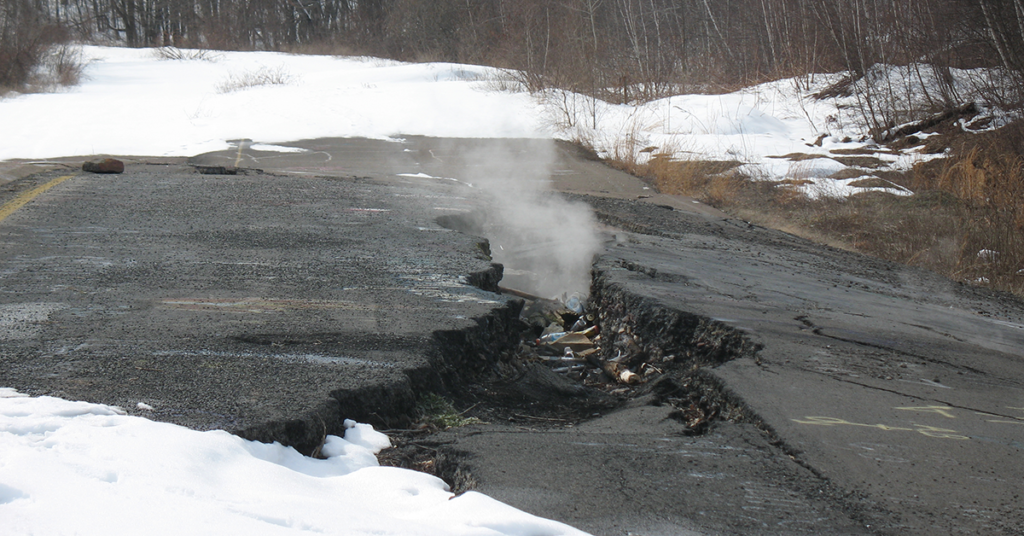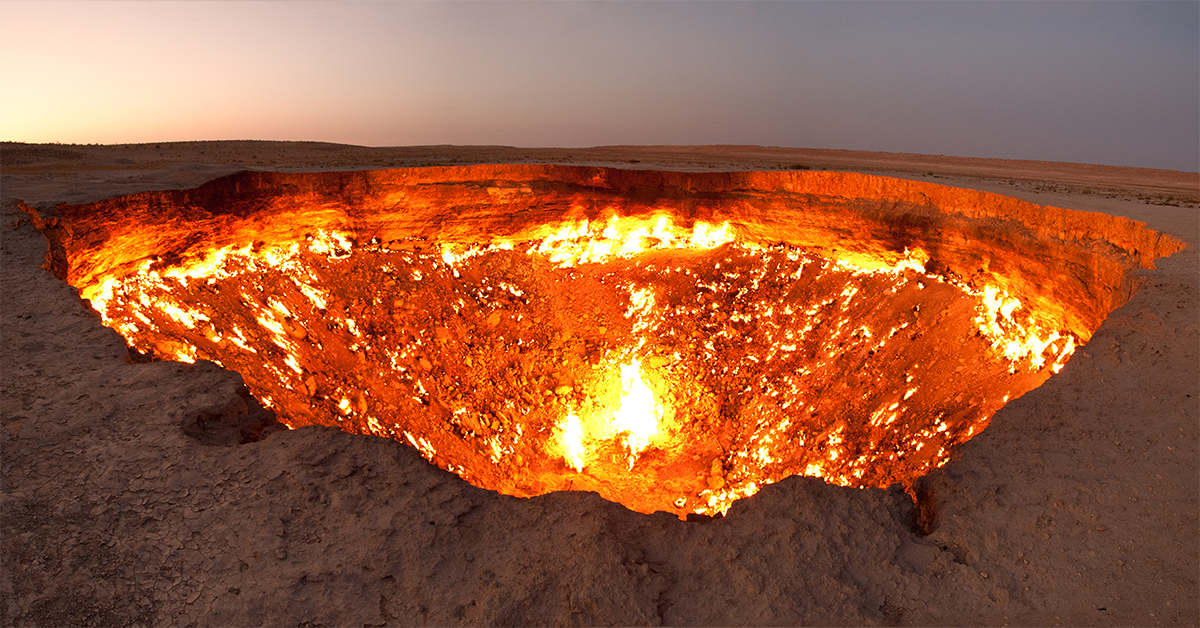There’s something off about the above picture. Did you notice it? Look closely. There’s a massive burning pit.
It’s known as the Door to Hell, a 230-foot-across crater in Darwaza, Turkmenistan that’s been actively on fire for nearly fifty years. When I’d first read about it, I assumed the conflagrant cavity had appeared naturally – maybe the ground just burned sometimes.
Not quite. The real origin of the exposed hellish depths tracks (in the most prominent story) back to 1971, when a Soviet drilling team scouted the area for oil hotspots. As they got to work drill, baby drilling digging in one potential desert site, the story goes that the ground beneath them, no longer able to sustain their weight, caved in over an expansive underground pocket of natural gas.
That collection of gas had been contained beneath the surface, but gases, known for their tendency to fill the container they’re in, lend themselves to wandering when released from their prisons. This gaseous mixture, mainly methane, now poured freely from its earthen cell and threatened the local fauna with methane poisoning (not fun), or massive explosion (considerably less fun). The drilling team acted quickly, deciding in the moment to burn the remaining collection of gas, a process they imagined would take weeks.
One week later, the gas burned bright. Weeks more… months more… forty-nine years later, it’s still going. This year will mark the fiftieth anniversary. Y’all down for a birthday bonfire?
This is the most common explanation. Some tell the story differently — by one group’s accounts, the crater and fire emerged together in 1971. In others, the crater came first in the 1960s and the fire significantly later in the 1980s. One story says humans broke the ground apart and another says it was nature who got there first. Maybe my “I guess this shit just happens” assumption was correct?
Blame aside, there’s a really big fire in the Turkmen desert. How big? 230 feet across, or ten feet off from being as wide as the Taj Mahal is tall. If you’ve never walked up the side of the Taj Mahal (disrespectful), two-thirds the size of a football field might be a better approximation.
The blaze is, far and away, Turkmenistan’s premiere tourist destination. People on Google give it 4.5 stars. I guess when you’re the tourism board for one of the world’s few remaining bona fide post-Soviet dictatorships with a pretty rough human rights record and a backyard composed mostly (70%) of sand, you take what you can get.


If you’re traveling on a budget, you might consider instead heading to Centralia, Pennsylvania, where smoke pours, not from one gaping hole in the ground, but from a series of tears in the city’s roads and fields. Beneath it all, a raging relatively calm inferno eats up the rich coal deposits whose wealth once sustained the town.
Centralia’s not the only other underground fire ambiently burning — it’s not even the only one in Pennsylvania. Smithsonian pegs the number of Pennsylvanian subterranean blazes at 38, but is kind to point out that that’s nothing compared to China’s 58. Given that Pennsylvania is way smaller than China and hosts under .01% of the population, I might argue it’s something compared to China’s 58.

Centralia is different from Darwaza in that, when the fire started, it wasn’t surrounded by a shitload of desert, but instead by a shitload of modest number of people. The thing about people and fire is that people don’t like to be on fire, at least not for long, and next to lost coal profits, human deaths are one of the worst things that can happen in a coal mining town. Also the world.
So, when the fire proved it wasn’t just a fad and really caught on, the government stepped in and evacuated the once-1,100-person city of Centralia, paying for the homes lost to the ensuing blaze.
Not everyone agreed to move. Ten people were left in Centralia when the 1990 census came through. Many, if not all of them, continue to live there today, but they’ve got agreements with the government to give up their land to the higher power of eminent domain when they die — in other words, Centralia’s days are limited. When all of its residents die, so does the town. Which is… true of every town, but this one’s gonna happen quicker.
The authorities in both Turkmenistan and Pennsylvania say they’re powerless to stop the fires — they’re too big, and anything short of complete control won’t cut it. So they keep raging. For how long? The best estimates hover around hundreds of years.
But these two aren’t the only such fires. Obviously — I just told you Pennsylvania has a bunch more. But the world at large has thousands of these guys. Sometimes they get ignited in mining accidents, sometimes it seems to happen naturally (as was the case for a 6,000-year-old fire in Australia), and sometimes, like in Indonesia, it comes from burning the shit out of thousands of acres of forests to make way for palm oil plantations. In other words, they accidentally started a few coal and gas fires amid their quest to blast the shit out of the environment. It happens.
Now comes the big question: are these fires harmful for the environment? Again, obviously. They’re huge coal fires that, from our perspective, are going to burn forever. We’re just starting to get uncomfortable with the consequences of purposeful coal burning. These guys are doing the worst of it for free and with no benefit.
Once lit, these underground fires are difficult to impossible to contain. In certain cases, governments have decided it’s safe to let them burn out on their own with minimal economic and safety concerns. On a small enough scale, substantial ecological harm can be mitigated. But in a broader world where our track record on climate protection is slightly subpar, it’s hard to ignore the undoubtable repercussions of regularly lighting century-long fires for no reason.
There’s no plan to try to put out the Centralia mine fire. The Pennsylvania state government says it doesn’t have enough cash. As far as the Turkmen government is concerned, the Darvaza Crater generates money. On one hand, it’s awful for the environment. On the other… 4.5 stars.
Read More
- Darvaza Gas Crater
- Dropping in on Turkmenistan’s ‘door to hell’ – in Pictures by Maeve Shearlaw for The Guardian
- Q&A: The First-Ever Expedition to Turkmenistan’s “Door to Hell” with George Kouruounis for National Geographic
- This Hellish Desert Pit Has Been On Fire for More Than 40 Years by Natasha Geiling for Smithsonian Magazine
- Centralia Mine Fire
- Fire in the Hole by Kevin Krajick for Smithsonian Magazine
- Inferno: The Centralia Mine Fire by Jon Guss
- Pictures: Centralia Mine Fire, at 50, Still Burning With Meaning by National Geographic
Images
- Darvasa gas crater panorama by Flickr user Tormod Sandtorv (cropped)
- Sourced through the Creative Commons Attribution-Share Alike 2.0 Generic license
- Smoke Rising From The Former Pennsylvania Route 61 by Wikipedia user LaesaMajestas (cropped)
- Sourced through the Creative Commons Attribution-Share Alike 4.0 International license


